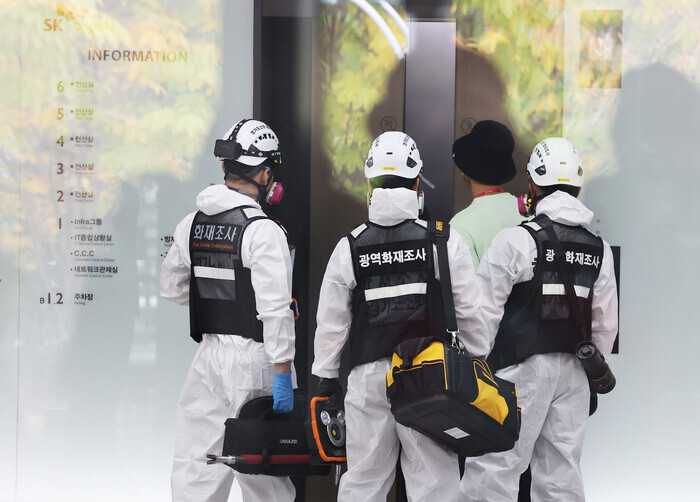hankyoreh
Links to other country sites 다른 나라 사이트 링크
Mass service outage exposes drawbacks of tech giant Kakao’s empire in Korea

A fire broke out in an underground electrical room of SK C&C’s data center in Pangyo on Saturday afternoon, causing a mass service outage for companies, namely Naver and Kakao, with servers housed there.
While Naver managed to restore most of its services within roughly four hours of the failure, services provided by Kakao, such as KakaoTalk and KakaoMap, remained offline or spotty until Sunday afternoon.
Critics have pointed out that Kakao, a service provider whose cornering of key online infrastructure has real-world consequences for Koreans’ daily lives, has neglected to prepare for crises by not investing in or establishing a real-time backup system. Some say that the weekend’s outage reveals the limitations of so-called Internet powerhouse Korea’s “national messenger service,” KakaoTalk.
According to the Ministry of Science and ICT, Kakao, SK C&C, and firefighting authorities on Sunday, a fire broke out in the underground electricity room of a data center in Pangyo at 3:30 pm on Saturday, causing Internet services provided through the servers in the building to crash.
Servers for major Kakao services such as KakaoTalk, Daum search portal/news/internet cafes, Kakao Map, Kakao T, and Kakao Pay were concentrated there.
Yang Hyun-seo, the vice president of Kakao, attended a meeting presided over by Science and ICT Minister Lee Jong-ho at the site of the fire earlier in the day, where he said, “We have distributed data centers in four cities across the country including Bundang and Anyang, but what happened today was that the power to 32,000 servers in the Bundang data center, which handles the most data, was cut off.”
He went on to mention that usually KakaoTalk aims to resolve any crashes within 20 minutes, but the response was delayed due to the fire impeding entry to the building and the large amount of server transmission.
According to Kakao, the power supply to 12,000 servers resumed as of 11 am Sunday, but the remaining 20,000 units are still down and without power. For this reason, some functions, such as sending and receiving texts via the messenger, were restored early in the day, but most of the remaining functions were still not fully back online.
Users are not the only people criticizing Kakao for its lack of emergency preparation.

The government and various political circles have been quick to wonder if Kakao has been providing services without having a proper backup system such as server redundancy (two servers operating in the same state for each function at the same time). Many have expressed outrage that it took only a single fire in one data center to bring numerous services used every day by millions of Koreans to a screeching halt.
Commenting on the crash, a government official referred to an incident in November 2018 in which KT’s Ahyeon branch caught fire, paralyzing the communication network in Seoul’s Mapo District and the surrounding area.
“That incident brought to light how several financial and public service institutions and companies did not properly duplicate their networks,” they said.
The official stated that in preparation for natural disasters such as earthquakes, floods, or fires, servers that do the same operation in synchronization should be placed in data centers based in different regions.
For example, Google and Meta operate backup servers in various continents and countries in preparation for disasters such as earthquakes or possible nuclear war.
In response to such criticisms, Kakao said that there are “no problems” with its dualization process.
“Despite being prepared for server redundancy, even when one looks at the entire history of Korea’s information technology industry a paralysis of this scale in which an entire data center crashed was unprecedented, meaning that there were so many servicer failures that it was difficult for other data centers to accept all of the data and traffic in place of the servers that had failed,” commented Yang, the company’s vice president.
However, given that data backup, server redundancy, and even real-time backup systems should be considered investments for emergency situations, it’s unlikely that Kakao will be let off the hook easily for having to deal with an “unprecedented circumstance.”
Kim Seung-joo, a professor at Korea University’s School of Cybersecurity, said, “When companies decide how to divide data for the sake of server redundancy, it is impossible to not consider the cost.”
Kim went on to say that it appeared that Kakao was “unable to respond properly to an accident that was far bigger than anything that they expected.”
By Chung In-seon, staff reporter; Ock Kee-won, staff reporter
Please direct questions or comments to [english@hani.co.kr]

Editorial・opinion
![[Column] Season 2 of special prosecutor probe may be coming to Korea soon [Column] Season 2 of special prosecutor probe may be coming to Korea soon](https://flexible.img.hani.co.kr/flexible/normal/500/300/imgdb/original/2024/0426/3317141030699447.jpg) [Column] Season 2 of special prosecutor probe may be coming to Korea soon
[Column] Season 2 of special prosecutor probe may be coming to Korea soon![[Column] Park Geun-hye déjà vu in Yoon Suk-yeol [Column] Park Geun-hye déjà vu in Yoon Suk-yeol](https://flexible.img.hani.co.kr/flexible/normal/500/300/imgdb/original/2024/0424/651713945113788.jpg) [Column] Park Geun-hye déjà vu in Yoon Suk-yeol
[Column] Park Geun-hye déjà vu in Yoon Suk-yeol- [Editorial] New weight of N. Korea’s nuclear threats makes dialogue all the more urgent
- [Guest essay] The real reason Korea’s new right wants to dub Rhee a founding father
- [Column] ‘Choson’: Is it time we start referring to N. Korea in its own terms?
- [Editorial] Japan’s rewriting of history with Korea has gone too far
- [Column] The president’s questionable capacity for dialogue
- [Column] Are chaebol firms just pizza pies for families to divvy up as they please?
- [Column] Has Korea, too, crossed the Rubicon on China?
- [Correspondent’s column] In Japan’s alliance with US, echoes of its past alliances with UK
Most viewed articles
- 1AI is catching up with humans at a ‘shocking’ rate
- 2After election rout, Yoon’s left with 3 choices for dealing with the opposition
- 3[Column] Season 2 of special prosecutor probe may be coming to Korea soon
- 4No good, very bad game for Korea puts it out of Olympics for first time since 1988
- 5Korea’s 1.3% growth in Q1 signals ‘textbook’ return to growth, says government
- 6Is Japan about to snatch control of Line messenger from Korea’s Naver?
- 7[Column] Park Geun-hye déjà vu in Yoon Suk-yeol
- 8Division commander ordered troops to enter raging flood waters before Marine died, survivor says
- 9Marriages nosedived 40% over last 10 years in Korea, a factor in low birth rate
- 10‘We must say no’: Seoul defense chief on Korean, USFK involvement in hypothetical Taiwan crisis